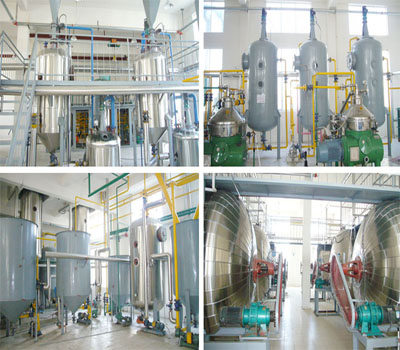Refining process of edible oil refinery
The edible oil produced by pressing or leaching process contains a series of impurities, such as colloid-soluble impurities, free fatty acids, pigments, odor substances, etc. These impurities not only affect the flavor and color of edible oil, but also easily deteriorate the edible oil and affect its storage stability. Therefore, it is necessary to use edible oil refining equipment to refine and purify it to make it more suitable for eating and storage. So, what are the refining processes of edible oil refinery?

Edible oil refinery is a refining process for edible oil refining, which generally includes deacidification, decoloration, deodorization, dehydration and dewaxing.
The first is the deacidification process. Deacidification refers to the process of removing free fatty acids and some impurities dissolved in edible oil. The common deacidification methods are alkali refining and physical deacidification. Alkali refining method is to mix edible oil with alkali liquor to saponify free fatty acids with alkali to generate soap, and then separate the soap by centrifugation or filtration, so as to achieve the purpose of deacidification. The principle of physical deacidification is to evaporate free fatty acids and some impurities under high temperature and high vacuum, so as to achieve the purpose of deacidification.
Next is the decolorization process. Decolorization refers to the process of removing pigment from edible oil. The common decolorization methods are activated clay adsorption and activated carbon adsorption. Activated clay adsorption method is to mix activated clay and edible oil, so that the clay can adsorb the pigment in edible oil, and then the activated clay and the adsorbed pigment can be separated by filtration, thus achieving the purpose of decoloration. The principle of activated carbon adsorption is to mix and stir activated carbon with edible oil, so that the activated carbon can adsorb the pigment in edible oil, and then the activated carbon and the adsorbed pigment can be separated by filtration, thus achieving the purpose of decoloration.
Then the deodorization process. Deodorization refers to the process of removing odor substances from edible oil. Common deodorization methods include high temperature steam deodorization and vacuum distillation deodorization. High-temperature steam deodorization method is to mix edible oil with steam at high temperature, so that the odorous substances are volatilized together with the steam, and then the volatilized odorous substances are condensed into liquid by a condenser, thus achieving the purpose of deodorization. The rule of vacuum distillation deodorization is to heat the edible oil under vacuum to volatilize the odorous substances, and then condense the volatilized odorous substances into liquid through the condenser, thus realizing the purpose of deodorization.
Followed by the dehydration process. Dehydration refers to the process of removing water from edible oil. The common dehydration methods are vacuum drying and molecular sieve adsorption. Vacuum drying method is to heat edible oil under vacuum condition to volatilize water, and then condense the volatilized water into liquid through condenser, thus achieving the purpose of dehydration. The molecular sieve adsorption rule is to mix and stir the molecular sieve with the edible oil, so that the molecular sieve can absorb the water in the edible oil, and then separate the molecular sieve from the absorbed water by filtration, thus achieving the purpose of dehydration.
Finally, the dewaxing process. Dewaxing refers to the process of removing solid esters from edible oil. The common dewaxing methods are freeze crystallization and solvent crystallization. Freeze crystallization method is to freeze and crystallize edible oil at low temperature to precipitate solid esters, and then separate the precipitated solid esters by filtration, thus achieving the purpose of dewaxing. The law of solvent crystallization is to mix an appropriate solvent with edible oil to dissolve the solid esters in the solvent, and then crystallize the solid esters dissolved in the solvent through a crystallizer, so as to achieve the purpose of dewaxing.
To sum up, the refining process of edible oil refinery includes deacidification, decoloration, deodorization, dehydration and dewaxing, which can effectively improve the quality and nutritional value of edible oil and ensure people’s healthy diet.
